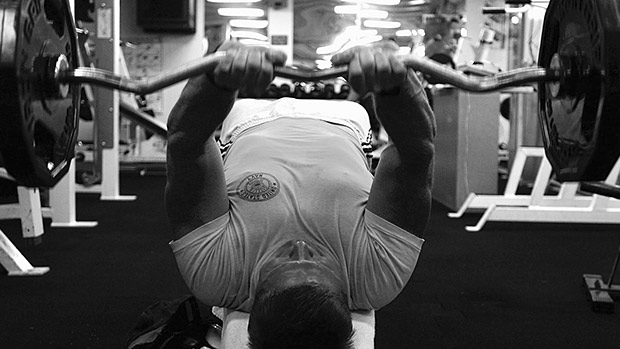This article is fairly good in that it identifies "effective" reps but falls short by not introducing Myo Reps. In effect, Charles forget to add efficiency into the equation.
3 Ways to Minimize Junk Training
Economize Your Workouts for Maximum Gains
by Charles Staley | Today

Not many things are crystal clear when it comes to muscle hypertrophy research, but one conclusion pops up over and over: Of all the many training variables, volume seems to correlate the most directly with muscle growth. Basically, volume is the total number of exercises, sets, and reps you do.
As with all things, however, more isn't always better, and volume is no exception. That's because volume comes not only with benefits (muscle growth), but drawbacks (fatigue).
Fortunately for thinking lifters, it's possible to distinguish highly effective, result-producing volume from less effective volume. Once we've done this, we can employ strategies to maximize the former and minimize the latter.
Not All Reps Are Created Equal
Traditionally, training volume is thought of as the total amount of work you perform, per unit of time. In sports science, volume is typically calculated by multiplying weight x reps. Simple enough. While it's effective for analytical work, it's doesn't work that well in practice because all volume isn't equal in terms of training benefits.
Whenever you do a workout, it's always a mixture of "effective" reps and, let's just say, junk reps. In the interest of efficiency, you'd like to skew that ratio as close to the "effective" side of the spectrum as possible.
Let's imagine that you do a set of 15 with 185 on the barbell bench press. This set was hard, so difficult in fact, that you BARELY got that 15th rep, and you would've certainly failed if you went for a 16th. Was this an effective set for muscle-building purposes? Yes, no doubt. However, not all of those reps were equally effective.
If you were to rank those 15 reps according to their relative effectiveness, rep number 1 would be the least effective and rep 15 would be most effective. Nothing too thought-provoking so far, right? The premise that underlies this observation is the fact that your sets must be taken to failure or at least close to failure if you expect them to have a stimulatory effect on muscle growth.
Muhammad Ali understood this concept instinctively decades ago: "I don't count my sit-ups. I only start counting when it starts hurting..."

Strategies For Reducing "Junk Reps"
Of course, to even reach those painful reps Ali talked about, you've gotta do a certain number of reps that count, both during your warm-up sets as well as work sets. The key here is to do just enough, but not one rep more than necessary. Here are three key strategies for accomplishing just that:
1 – Identify and Economize Your Warm-Up Sets
Every time you do a set, you should be very clear about whether or not you're doing a warm-up set or a work set. Using a real-world example, let's say that your goal for the workout is 4 sets of 8 reps with 155 pounds on the military press.
Your first set might be 10 reps with the empty bar. Next, 85x8. Both of these sets were clearly "warm-up" sets, but you're not quite ready for 155. You'll need one more set to bridge the gap between 85 and 155.
Some lifters call this a "prep" set, and since the reps in this set qualify as "necessary but useless," we want to do as few of them as possible. This will vary from person to person and from workout to workout, but probably 3-5 reps will do the trick. From here, you're ready to tackle your result-producing work sets.
In your own workouts, get in the habit of distinguishing between warm-up, gap, and work sets. Then, vary your work output accordingly. Rather than using the same number of reps for all warm-up and work sets (as many lifters do), perform your warm-ups in a "pyramid" style to save your energy for when it really counts.
Let's say my goal is to deadlift 375 pounds for 10 reps. Here's how I'd warm-up and "prep set" for that workout:
Incidentally, the bigger the exercise is, the more important this strategy becomes. For "small" movements such as direct biceps and calf exercises, you'll recover so fast you won't need to worry much about saving your energy during warm-ups. But for big movements like squats, deads, and presses, economizing your warm-ups is a key success tactic.
2 – Stay in the 8-12 Range Most of the Time
As I wrote in 4 Proven Tactics for Faster Muscle Growth, 8-12 reps per set tends to be the "sweet spot" for muscle-building purposes. While the scientific consensus is that muscle can be built using anything from 3 to 30 reps, both extremes come with significant costs:
Note: Sometimes your circumstances and goals may warrant low-rep sets in particular. One scenario would be a desire to get stronger in a maximum-strength type of way. Another might be when you've plateaued due to several months of training in the 8-12 range. In this scenario, a brief change of pace, using low (or high, for that matter) rep sets will be just what you need to stimulate continued adaptation.
3 – Rethink Your Habit of Using Straight Sets
As I described in The End of 3x10, if you usually do the same weight for straight sets (for example, 225 for 5 sets of 10), you're likely doing too many unnecessary junk reps, and here's why:
If you take your first set of 10 sufficiently close to failure, it's unlikely that you could do 4 more sets of 10 with that same weight. Sure, there are exceptions to this rule (the first week of a new training cycle would be one), but generally speaking, if you've worked as hard as you should on set one, successive sets will require you to gradually drop weight, reps, or both. This "varied," vastly superior strategy might look something like this:
As I often remind my clients, resources, especially time, energy, and orthopedic integrity, are always limited. Smart lifters, especially as they gain experience, benefit tremendously by constantly seeking and employing resource-sparing strategies like the ones outlined here.
Training hard is absolutely essential, but the magic doesn't happen until hard work is also smart work.
Related: Turn Up the Volume
Related: The Best Damn Workout Plan For Natural Lifters

Charles Staley
Charles Staley is an accomplished strength coach who specializes in helping older athletes reclaim their physicality and vitality. At age 56, Charles is leaner than ever, injury free, and in his lifetime best shape. His PRs include a 400-pound squat, 510-pound deadlift, and a 17 chin-up max.
Follow Charles Staley on Facebook
3 Ways to Minimize Junk Training
Economize Your Workouts for Maximum Gains
by Charles Staley | Today

Not many things are crystal clear when it comes to muscle hypertrophy research, but one conclusion pops up over and over: Of all the many training variables, volume seems to correlate the most directly with muscle growth. Basically, volume is the total number of exercises, sets, and reps you do.
As with all things, however, more isn't always better, and volume is no exception. That's because volume comes not only with benefits (muscle growth), but drawbacks (fatigue).
Fortunately for thinking lifters, it's possible to distinguish highly effective, result-producing volume from less effective volume. Once we've done this, we can employ strategies to maximize the former and minimize the latter.
Not All Reps Are Created Equal
Traditionally, training volume is thought of as the total amount of work you perform, per unit of time. In sports science, volume is typically calculated by multiplying weight x reps. Simple enough. While it's effective for analytical work, it's doesn't work that well in practice because all volume isn't equal in terms of training benefits.
Whenever you do a workout, it's always a mixture of "effective" reps and, let's just say, junk reps. In the interest of efficiency, you'd like to skew that ratio as close to the "effective" side of the spectrum as possible.
Let's imagine that you do a set of 15 with 185 on the barbell bench press. This set was hard, so difficult in fact, that you BARELY got that 15th rep, and you would've certainly failed if you went for a 16th. Was this an effective set for muscle-building purposes? Yes, no doubt. However, not all of those reps were equally effective.
If you were to rank those 15 reps according to their relative effectiveness, rep number 1 would be the least effective and rep 15 would be most effective. Nothing too thought-provoking so far, right? The premise that underlies this observation is the fact that your sets must be taken to failure or at least close to failure if you expect them to have a stimulatory effect on muscle growth.
Muhammad Ali understood this concept instinctively decades ago: "I don't count my sit-ups. I only start counting when it starts hurting..."

Strategies For Reducing "Junk Reps"
Of course, to even reach those painful reps Ali talked about, you've gotta do a certain number of reps that count, both during your warm-up sets as well as work sets. The key here is to do just enough, but not one rep more than necessary. Here are three key strategies for accomplishing just that:
1 – Identify and Economize Your Warm-Up Sets
Every time you do a set, you should be very clear about whether or not you're doing a warm-up set or a work set. Using a real-world example, let's say that your goal for the workout is 4 sets of 8 reps with 155 pounds on the military press.
Your first set might be 10 reps with the empty bar. Next, 85x8. Both of these sets were clearly "warm-up" sets, but you're not quite ready for 155. You'll need one more set to bridge the gap between 85 and 155.
Some lifters call this a "prep" set, and since the reps in this set qualify as "necessary but useless," we want to do as few of them as possible. This will vary from person to person and from workout to workout, but probably 3-5 reps will do the trick. From here, you're ready to tackle your result-producing work sets.
In your own workouts, get in the habit of distinguishing between warm-up, gap, and work sets. Then, vary your work output accordingly. Rather than using the same number of reps for all warm-up and work sets (as many lifters do), perform your warm-ups in a "pyramid" style to save your energy for when it really counts.
Let's say my goal is to deadlift 375 pounds for 10 reps. Here's how I'd warm-up and "prep set" for that workout:
- 135x10
- 225x6
- 315x4
- 345x1 (prep set)
- 375x10 (set of reps that "count")
Incidentally, the bigger the exercise is, the more important this strategy becomes. For "small" movements such as direct biceps and calf exercises, you'll recover so fast you won't need to worry much about saving your energy during warm-ups. But for big movements like squats, deads, and presses, economizing your warm-ups is a key success tactic.
2 – Stay in the 8-12 Range Most of the Time
As I wrote in 4 Proven Tactics for Faster Muscle Growth, 8-12 reps per set tends to be the "sweet spot" for muscle-building purposes. While the scientific consensus is that muscle can be built using anything from 3 to 30 reps, both extremes come with significant costs:
- Low-rep sets require very heavy weights, which means you'll need more warm-up sets and longer rests between sets. Heavy weights also put extra wear and tear on your joints and connective tissues.
- Very high-rep sets come with a very different cost. Since only the last 3-4 reps are considered "effective" – because that's when hypertrophy-producing fatigue reaches critical mass – the first 26-27 reps are "necessary but useless."
Note: Sometimes your circumstances and goals may warrant low-rep sets in particular. One scenario would be a desire to get stronger in a maximum-strength type of way. Another might be when you've plateaued due to several months of training in the 8-12 range. In this scenario, a brief change of pace, using low (or high, for that matter) rep sets will be just what you need to stimulate continued adaptation.
3 – Rethink Your Habit of Using Straight Sets
As I described in The End of 3x10, if you usually do the same weight for straight sets (for example, 225 for 5 sets of 10), you're likely doing too many unnecessary junk reps, and here's why:
If you take your first set of 10 sufficiently close to failure, it's unlikely that you could do 4 more sets of 10 with that same weight. Sure, there are exceptions to this rule (the first week of a new training cycle would be one), but generally speaking, if you've worked as hard as you should on set one, successive sets will require you to gradually drop weight, reps, or both. This "varied," vastly superior strategy might look something like this:
- Set 1: 225x10
- Set 2: 225x9
- Set 3: 225x8
- Set 4: 225x8
- Set 5: 225x8
- Or this:
- Set 1: 225x10
- Set 2: 215x10
- Set 3: 205x10
- Set 4: 205x10
- Set 5: 205x10
As I often remind my clients, resources, especially time, energy, and orthopedic integrity, are always limited. Smart lifters, especially as they gain experience, benefit tremendously by constantly seeking and employing resource-sparing strategies like the ones outlined here.
Training hard is absolutely essential, but the magic doesn't happen until hard work is also smart work.
Related: Turn Up the Volume
Related: The Best Damn Workout Plan For Natural Lifters

Charles Staley
Charles Staley is an accomplished strength coach who specializes in helping older athletes reclaim their physicality and vitality. At age 56, Charles is leaner than ever, injury free, and in his lifetime best shape. His PRs include a 400-pound squat, 510-pound deadlift, and a 17 chin-up max.
Follow Charles Staley on Facebook
